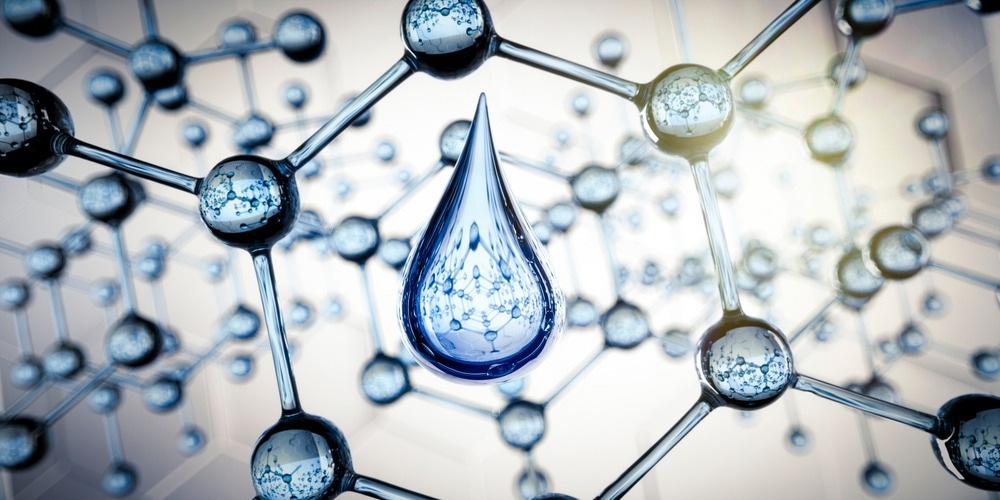Silica glass is a commonly used material for studying wetting behavior, and it exhibits complex interactions with water molecules. While traditional methods suggest uniform adsorption of water molecules on hydrophilic surfaces, recent advancements in interface-focused measurement techniques have revealed heterogeneous wetting behavior.

Image Credit: peterschreiber.media/Shutterstock.com
In a recent article published in the journal Scientific Reports, researchers from Japan studied the microscopic behavior of water on a silica glass surface using advanced visualization techniques. Through these experiments, the team aimed to provide insights into the complex interactions between water molecules and solid surfaces, particularly silica glass, and contribute to a better understanding of heterogeneous wetting behavior.
Background
The adsorption of water on material surfaces is a ubiquitous phenomenon with significant implications across various industries. While efforts have been made to mitigate the detrimental effects of water adsorption (through the development of hydrophobic coatings and surface microfabrication), water's role as a lubricant and protective coating has been historically recognized.
Understanding the interactions between water and solid surfaces is crucial for elucidating its catalytic effects and promoting catalytic reactions, as suggested by the tidal flat model of the origin of life. Despite its importance, the initial process of water adsorption on solid surfaces remains poorly understood, necessitating further investigation.
The Current Study
The study highlighted the preparation of the experimental sample (a piece of quartz glass), which was cleaned thoroughly to remove any surface contaminants. The cleaning process involved wiping the glass with ethanol and then immersing it in a piranha solution. Subsequently, UV-ozone cleaning was performed for four hours to ensure the removal of any residual organic contaminants. The glass sample was then fixed in an open liquid cell, and water was used to increase humidity.
A modified commercial frequency-modulation atomic force microscopy (FM-AFM) system was used to observe the surface topography. An incubator set the humidity to 25 °C in the FM-AFM system. The relative humidity (RH) within the incubator reached equilibrium at nearly 85 %.
For quantitative measurements of physical properties, peak force tapping microscopy was employed using an AFM operating in peak force tapping mode. The strongest force applied during retraction represented the adhesion force, with larger absolute values indicating stronger adhesion.
The observations were conducted at room temperature and humidity controlled from 0 to 85 %. The multi-point force curves were used to generate adhesion maps, providing insights into the surface properties of the quartz glass under varying humidity conditions.
Results and Discussion
The results and analysis highlighted in this study are summarized below:
In situ observation of the wetting process
Using FM-AFM, the wetting process on a silica glass surface was observed in situ. At 30 % RH, the surface appeared smooth, but at 50 % RH, circular adsorbates around 500 nm in diameter emerged. These droplets remained stable until the humidity dropped to 30 %, at which point they rapidly diminished in size and disappeared.
Despite thermal drift, consistent diffusion and repulsion behavior of these droplets were observed, indicating their dynamic nature. The density of droplets remained constant above 50 % RH, suggesting a homogeneous distribution.
Nano-water droplets under equilibrium RH
Under equilibrium RH of 85 %, an increase in the number of nano-water droplets was observed, although they exhibited reduced size compared to the previous humidity increase. Impurities on the glass surface influenced droplet formation, leading to heterogeneous nucleation. Unlike during humidity increase, these droplets did not diffuse, indicating static nucleation points.
Coexistence of nano-water droplets and nano-liquid film
The film thickness remained undetermined, but adhesion force mapping showed an irreversible increase in adhesion force with increasing humidity, indicating film formation. The droplets exhibited lower viscosity than the film, suggesting distinct physical properties. The droplets and film were found to coexist, with the film likely composed of a silica gel-like layer.
Interface structure of nano-water droplets
Despite similarities to bulk water, the repulsion between droplets indicated a unique interface structure possibly attributed to a robust hydrogen bonding network. These findings suggest potential applications for FM-AFM in elucidating the air-liquid interface structure of nanoscale water droplets in future research.
Conclusion
High-resolution AFM observations unveiled the spontaneous emergence of nano-water droplets on silica glass surfaces, suggesting a two-stage formation process involving both the glass surface and a silica gel-like layer. These findings extend beyond silica glass, potentially impacting materials with hydroxide layers or deliquescent salts.
Unique nano-water droplet behaviors, including surface diffusion and repulsion, hint at distinct interface structures. Their reversible evaporation and condensation promise applications in adsorbate control and substance transport on wet surfaces, opening avenues for friction control and catalytic reactions. Harnessing nano-water droplet dynamics may revolutionize surface engineering and environmental remediation efforts.
Journal Reference
Araki, Y., Minato, T., Arai, T. (2024). Microscopic behavior of nano-water droplets on a silica glass surface. Scientific Reports. doi.org/10.1038/s41598-024-61212-1